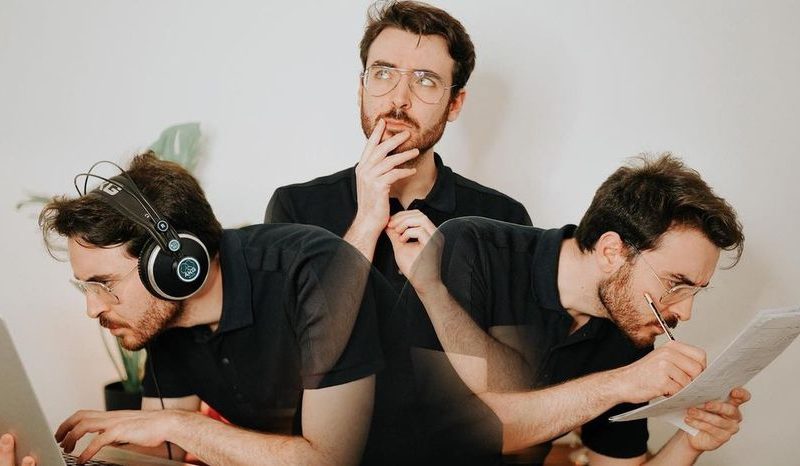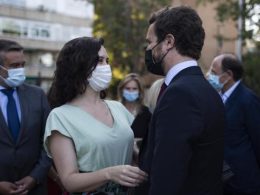They do not move to Andorra to pay less taxes or aspire to be millionaires, but the seven teachers who star in this report add up to 18 million followers on YouTube with their videos in Spanish in which they teach from counting on fingers to solving a very serious problem. complicated.
The new generations, who have grown up in audiovisual culture, find in these channels the way to understand concepts that bore them in class. The pandemic has served edutubers – that’s what educational youtubers are called ―To validate what they have been doing for years and has opened the door for other teachers to dare to share their knowledge on a channel, as they did in their beginnings as simple amateurs. Of the seven, only two (AlexProfe and Cristina Álvarez) are still on the staff of an educational center.
Julioprofe
Julio Alberto Ríos (Colombia). Mathematics and Physics since 2009
He has 4.9 million followers, the majority in Mexico and Colombia.
Julio Alberto Ríos, who graduated in Civil Engineering, has been a one-man orchestra for 12 years. Record, edit and broadcast your videos to nearly five million followers. His inspiration was the Spanish professor at the Polytechnic of Cartagena Juan Medina Molina, author of the matematicas.es channel, a pioneer with tutorials already in 2006. “Three years later I thought of giving extra math support to my high school and high school kids. university ”, remembers Ríos.
Now his classes are only on YouTube, although managing such a large audience is starting to weigh on him: “I have a hard time delegating, but I’m thinking of having a video editor,” he explains. “I am not using TikTok. I don’t have that spark. My videos are still very traditional, ”he says.
Since the pandemic, he has been broadcasting live. “First I say hello, then I ring a Christmas bell that I got myself [sounds in the background] and I say ‘Well, class begins here,” he says. “I go straight to the exercise and once finished, I read the questions, I comment …”. His greatest achievement is having gathered 213,586 people on the network to see one of his math classes live, which earned him entry into the Guinness Book of Records.
In order to have a more relaxed treatment, Julioprofe also plays games of video games with his virtual students that are broadcast on the same platform. Although his efforts are concentrated on teaching. “The exact sciences have always been considered tedious, for a minority, and we are showing that knowledge is at the service of those who want to learn with free tutorials.” To his surprise, he receives comments in Korean or Russian in which the authors assure him that they do not understand his language but do understand his explanation. “They want the explanation in English. Maybe later”.
Quantum Fracture
Author: Jose Luis Crespo (Spain). Physics since 2013
2.7 million followers, two-thirds from Latin America
The first thing that Crespo, a physicist, makes clear is that his objective with the channel is more dissemination than academic purposes. “There are channels that are proposed as support to the class and others that are dedicated to scientific dissemination, like us. And there are no rules, there are no equations … We have a little anti-system point, we like to teach in an alternative way.
We want them to have a good time and, if we can make them expand their scientific culture, all the better ”. And for that they pull “sense of humor, cultural references. It is a compendium of skills, also knowing how to tell stories, which you have to use so that something very abstract is not a pain in the neck ”.
“I started Quantum in 2013 as a hobby, I started talking about science and when I finished my degree I decided to do it professionally and it has gone quite well for me,” he recalls. He is not alone, he has set up an audiovisual production company for which five people work. A complex structure, with very elaborate videos, that requires funds to survive. “We make money from YouTube ads, from the merchandising we make – posters, t-shirts – and from crowdfunding with monthly subscriptions.”
Crespo is concerned about success: “Many kids tell us that they are going to study Physics because of our videos. We push them into STEM [tech] careers and it’s a huge responsibility. To what extent does a video in which we show you fireworks resemble a race of this type with the sacrifices that it implies? In his opinion, one of the problems with these subjects is that “there are people who know a lot, but do not want to lower the level, reach out.
They speak from above ”. Instead, he tries to make concepts understandable to a non-specialized audience, and sometimes in live broadcasts he combines preparing a recipe with explaining scientific concepts. “Any excuse is good to talk about science,” he concludes.
a teacher
Cristina Álvarez (Spain). Primary and secondary school subjects, since 2014
1.4 million followers. 65% of the audience in Spain
Cristina Álvarez does not want to stop being a primary school teacher, but she has had to ask for a reduction in working hours to dedicate hours to her channel. “He is like my third child”, sentence. What began as an individual project in 2014 with the technical help of the Link to Media company – “the parents asked me for resources to reinforce” – is today a huge project, with many subjects, in which a handful of teachers participate. with a website (unprofesor.com) in which exercises are downloaded and you can ask a primary or secondary teacher through a form.
Part of the content covers the first university courses of Biology or Philosophy. “It is very gratifying when a grandfather who stays with his grandson in the afternoons writes to you and thanks us for helping him with his homework,” she says proudly.
Before the course begins in a Teacher, they make an open selection to expand the number of collaborating teachers, because there is rotation. Álvarez is surprised by the “fear” that the camera arouses in teachers used to speaking in public. “You don’t just need to know a lot, but to have a special spark. There are very good people who do not serve, they die of shame “, he emphasizes.
Their audience goes up in test time – from three million to six a month – and they get a lot of traffic from Google because students are looking for, for example, how to make an equation. Álvarez has never been to Mexico and is surprised at the success there. “I think they like our pronunciation, the way we express ourselves in Spain.”
Math2Me
José Alejandro Andalón and María González (Mexico). Mathematics since 2009
2.6 million followers
Mexican schoolchildren finished classes last year on television and this year for many, luck has not changed and they are looking for resources to get ahead. “They have realized that the basis of the curriculum can be had with the videos,” says José Alejandro Aldón, who runs Math2Me with his wife, María González. Right now their brand – at first they sold lots of CDs with their classes – is spreading through all social networks with a frenetic pace that surprises other edutubers.
“The platform for the pandemic has been TikTok. They are very short videos, slide, slide, slide. By repetition, the human being gets used to consuming in this way. Even the grown-ups want dynamic content. You also give a teacher a talk with a PowerPoint and a fixed text and you lose him ”.
“The traditional school does not respond to the functioning of the brain”
His seven-minute videos dwindle over the months. “The contents have to be very practical and concrete”, they justify. “When the students return to school it will be entertaining to see how you put an hour of class for them per subject,” they continue.
Marriage poses a common problem: there are hardly any women among the followers. “A few years ago 70% of the audience was male, and I commented on it with Alejandro because the classes we do are secondary and high school, in which there are many women. I started to go on camera a little to see if that could have an impact because they did not feel identified and from two or three years ago we saw the change. If I’m in the video, at the moment we have 50% women ”.
Unicoos
David Calle (Spain)
Mathematics, Physics, Chemistry and Technology since 2006
1.44 million followers. Two thirds in Spain
Rare is the first or second year student in a technical career that Unicoos, by David Calle, a media teacher since he was a finalist in 2017 for the World Teacher Prize (Prize for the best teacher in the world) with his classes online. Calle created his channel so that his students in his academy could review what they had learned by rewinding, and he dedicated more time to it when many had to abandon face-to-face classes due to the previous economic crisis of 2008-2011.
Since then he has made both teachings compatible. This Telecommunications engineer laments the lack of institutional support in Spain and the lack of interest of the brands and compares it with the Khan Academy ―A website that houses 7,000 videos to which more than 100 million people are subscribed―, which receives millions of dollars in the United States.
Calle’s project, which employs eight people, is not limited to YouTube alone; includes two web pages – which work with subscriptions – with exams, materials and tutorials. In this EVAU, for the first time, he has made live broadcasts in which he corrected model exams in Madrid. “The level of demand has dropped, and especially in ESO,” he laments.
That is why 70% of its audience is concentrated between the ages of 17 and 24. “When they get to engineering, they have to practice a lot.” Technical vocations have fallen by 25% in a decade and Calle is furious that “the brightest students do not opt for engineering but for health sciences, for care. They don’t realize that creating a computer program also saves lives ”.
Mathematics Profe Alex
Alexander Gómez (Colombia). Maths and physics
5 million followers. 30% in Mexico
Alexander Gómez, a graduate in Mathematics and Statistics, created the channel to help his students, like so many others, and as a final postgraduate project. “I was surprised when I saw that other countries were watching the videos,” he acknowledges. Now 30% of its audience is in Mexico. “Mexicans are more used to it. In the rest of South America we did not see YouTube as a tool to learn something ”.
The platform gives the option of slicing the videos, but Profe Alex, who usually speaks for 15 minutes in front of the camera, does not consider it: “I know it would give more money to make them short, to get people’s attention … But I think when one teaches in 10 seconds gives a brushstroke over the subject, and it is not effective. If they don’t teach you why five plus two equals seven, or why a half equals two quarters, knowledge is forgotten, it is not applied in life ”.
“I always start with very easy things, which may seem silly, so that the student is motivated and then we put a little more difficulty”, says his trick. Why is mathematics the bone subject? “If the child is told that they are difficult, he will not want to enter the world of mathematics. In addition, it is taught in brush strokes without understanding why, when mathematics is like a column in which you have to have a very good base to go up. And, suddenly, the teachers don’t teach us how to teach either ”.
“I don’t have enough time and I am thinking of withdrawing from school, but this has been very important to understand people’s thinking,” confesses Álex. A year and a half ago, tired, he asked for help. “I started to delegate and there is someone who edits me, another who helps me with social networks …”, he says. This way, he takes time to, like Ríos, play with the fans in broadcast games. “Let them see that we also had a good time.”









